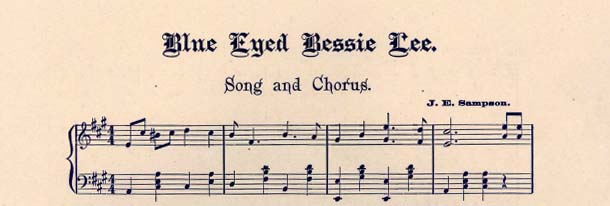
Historic Sheet Music Collection
Document Type
Score
Publication Date
1837
Lyrics
Tenderly but not too slow
True love can ne'er forget
fondly as when we met
Dearest I love thee yet, my darling one!
Thus sung a minstrel grey
His sweet impassiond lay
Down by the Ocean's spray
At rise of sun
But wither'd was the minstrel's sight
Morn to him was dark as night
Yet his heart was full of light
As he this lay begun
True love can ne'er forget
fondly as when we met
Dearest I love thee yet, my darling one!
Long year are past and o'er
Since from this fatal shore
Cold hearts and cold winds bore my love from me
Scarcely the minstrel spoke
When quick with flashing stroke
A boat's light oar the silence broke over the sea
Soon upon her native strand
Doth a lovely Lady land
While the Minstrel's love taught hand
Did o'er his sweet harp run.
True love can ne'er forget
fondly as when we met
Dearest I love thee yet, my darling one!
Where the Minstrel sat alone
There that Lady fair hath gone
Within his hand she plac'd her own
The Bard dropt on his knee
From his lip soft blessings came
He kiss'd her hand with truest flame
In trembling tones he nam'd her name
Though her je could not see
But oh! the touch the Bard could tell
Of that dear hand remember'd well
Ah! by many a secret spell
Can True love trace his own
For True love can ne'er forget
Fondly as whey they met
He lov'd his Lady yet
His darling one.
Recommended Citation
Lover, Samuel, "True Love Can Ne'er Forget" (1837). Historic Sheet Music Collection. 531.
https://digitalcommons.conncoll.edu/sheetmusic/531
The views expressed in this paper are solely those of the author.
Comments
True love can ne'er forget
A favorite ballad from the songs of the legends and traditions of Ireland
As sung by Madame Caradori Allan
Written and composed by Samuel Lover
It is related of Carolan, the Irish bard, that after his loss of sight, and the lapse of twenty years, he recognised his first love by the touch of her hand
Some of the resources may contain offensive language or negative stereotypes. Such materials should be seen in the context of the time period and as a reflection of attitudes of the time. The items are part of the historical record, and do not represent the views of the libraries or the institution.